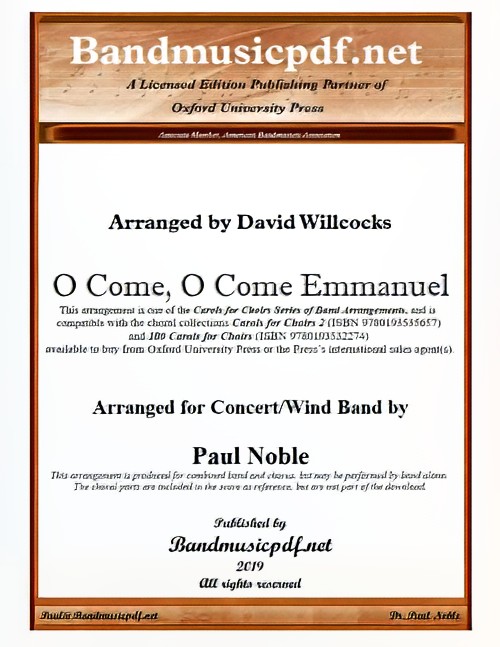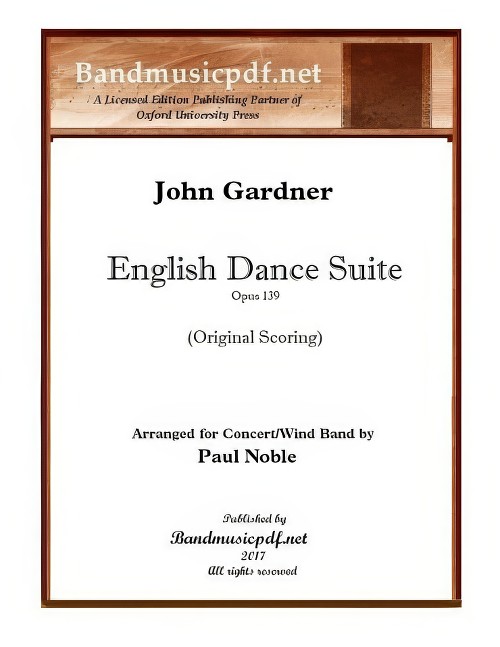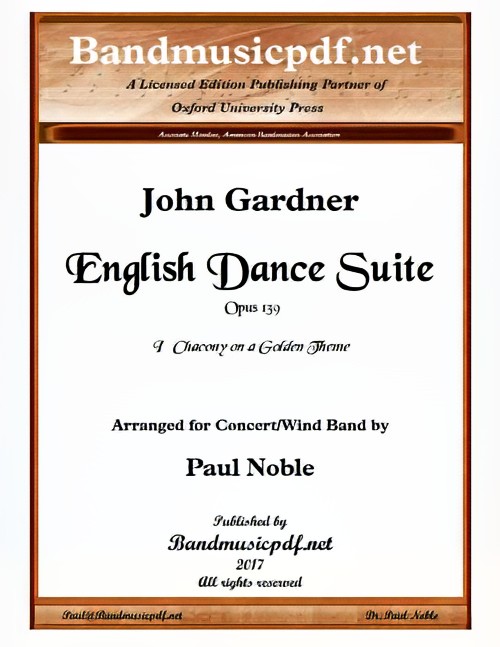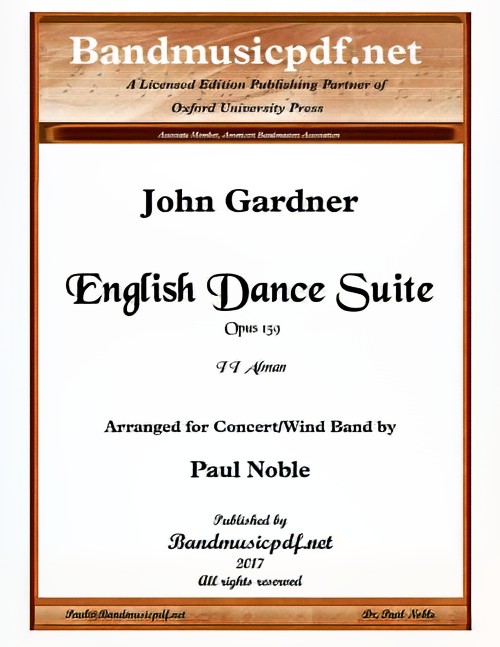Results
-
 £179.99
£179.99Ivam - Ferrer Ferran
Since it opened in 1989 the Institute for Modern Art in Valencia (Instituto Valenciano de Arte Moderne or simply IVAM) has taken centre stage in advancing and researching all forms of 20th century art. Ferrer Ferran was inspired by the spirit of modern art to compose IVAM, an expressive anddazzling symphonic overture for band. A feast of sound!
Estimated dispatch 7-14 working days
-
 £57.50
£57.50The Spirit Endures - James L. Hosay
An uplifting tone poem for band, this one is a truly beautiful expression built upon rich texture and artfully-phrased melody. From a simple hymn-like opening, the piece builds relentlessly to an intense and inspiring finale. James L. Hosay is one of the modern concert band's literature's great composers of melody. So often modern band pieces are built upon a couple of simple ostinato figures at the expense of any real extended thematic material. Itis indeed refreshing and rewarding to have a beautiful melody to play. Play it!
Estimated dispatch 7-14 working days
-
 £104.99
£104.99Famous German Christmas Songs
Most of the German carols that are still popular today date from the period between the 17th and the early 19th centuries. Thus, only very few modern musical approaches to these songs can be found. Stefan Schwalgin has taken the opportunity to give five well-known German Christmas melodies a new sound in this colourful modern arrangement. Contains: Silent Night, Ihr Kinderlein kommet, Zu Bethlehem geboren, Alle Jahre wieder and O du frhliche. At a little bit of German Christmas spirit with this beautiful medley.
Estimated dispatch 7-14 working days
-
£301.00
Praise Jerusalem! - Alfred Reed
A major work of lasting importance for the modern symphonic band or wind ensemble by this acknowledged master of the medium. This set of variations on a 7th Century Armenian Communion Easter hymn calls forth every possible sound, color and tonal effect, showing off the winds, brasses and percussion of the modern band in all their glory. An overwhelming conclusion that blends an additional six-voice brass choir with the full band makes this one of the finest closing works for a concert in many years.
Estimated dispatch 7-14 working days
-
£106.95
Spirals Of Light - Sean O'Loughlin
From the brilliant fanfare figures of its opening through the various transformations of the 6/8 melody introduced by the alto saxophone, Spirals of Light charts an invigorating course that expertly exploits the kaleidoscope of colors available from the modern concert band. In addition, this dazzling selection makes striking use of the contrast between simple and compound time and is sophisticated in its use of syncopation and modern harmony.
Estimated dispatch 7-14 working days
-
£140.50
Upon A New Horizon - Larry Clark
Three contrasting movements ("Into the Future", "Who Has Ever Touched the Sun?" and Rondo: "In the Nick of Time") make a modern suite, that is an excellent study in coloristic scoring for the modern concert band. The syncopations and use of angular melodic ideas will be somewhat challenging for advancing bands and help to make Upon a New Horizon an ideal showpiece for contest and festival performances. Duration: 9'
Estimated dispatch 7-14 working days
-
 £75.00
£75.00O Come, O Come Emmanuel (Concert Band with Optional Choir - Score and Parts) - Noble & Willcocks
O come, O come Emmanuel is a Christian hymn for Advent and Christmas. It is a translation of a Latin hymn, Veni, veni, Emmanuel, itself a metrical paraphrase of the O Antiphons, a series of plainchant antiphons attached to the Magnificat at Vespers over the final days before Christmas. The 1861 translation from Hymns Ancient and Modern is the most prominent by far in the English-speaking world, but other English translations also exist., Translations into other modern languages (particularly German) are also in widespread use. This arrangement for Concert/Wind Band represents one in the series of band arrangements compatible with David Willcocks Carols for Choirs, Book 2 (#27).
Estimated dispatch 7-14 working days
-
 £495.00
£495.00English Dance Suite (Concert Band - Score and Parts) - Gardner, John - Noble, Paul
Original Scoring. Arranged for the modern Concert/Wind Band, scored for three trumpets, reasonable doubling of parts where the original musical effect is not altered so that players can have a more responsible and enjoyable experience, more legible parts with less doubling on one staff, etc. The piece is offered either as a complete suite of seven movements, and also as seven individual movements which may be purchased independently. The English Dance Suite was originally composed by John Gardner for Wind Band, and has been re-set for the modern Concert Band instrumentation. Both the original version, edited and type-set by Paul Noble, and this arrangement are first editions now available for purchase to bands around the world. The set of seven Renaissance dances depict John Gardner's love of Scottish music, the Renaissance heritage, and some of his own mischievous approach to music. The first movement, Chacony on a Golden Theme, reminiscent of the Allegro movement of Purcell's Golden Sonata, is much used as a vehicle for variation on a repeated short harmonic progression, often involving a fairly short repetitive bass-line which offered a compositional outline for variation, decoration, figuration and melodic invention. In this it closely resembles the passacaglia. The Alman originated in the 16th century as a duple metere dance of moderate tempo, already considered very old, with a characteristic double-knocking upbeat of one or occasionally three sixteenth notes. It appears to have derived from a German dance but no identifiable dance and no German dance instructions from this era survive. The Hornpipe, usually in 3/2 dance rhythm, is an Irish, Scottish and English dance. It is done in hard shoes, which are used to help keep track of how the dancer keeps in time. There are two variations of the hornpipe dance: fast and slow. Usually, more experienced dancers will do the slow hornpipe but younger dancers will start out with the fast hornpipe and then switch in later years. The Corranto is a 16th-century court dance characterized by short advances and retreats, in quick triple time. The Volta (Italian: the turn or turning) is an anglicised name from the later Renaissance. Its main figure consisted of a turn and lift in a sort of closed position. The Pavan is a slow processional dance common in Europe during the 16th century. The Reel, indigenous to Scotland, consists largely of quaver (eighth note) movement with an accent on the first and third beats of the bar.
Estimated dispatch 7-14 working days
-
 £125.00
£125.00English Dance Suite - I. Chacony on a Golden Theme (Concert Band - Score and Parts) - Gardner, John - Noble, Paul
Arranged for the modern Concert/Wind Band, scored for three trumpets, reasonable doubling of parts where the original musical effect is not altered so that players can have a more responsible and enjoyable experience, more legible parts with less doubling on one staff, etc. The piece is offered either as a complete suite of seven movements, and also as seven individual movements which may be purchased independently. The English Dance Suite was originally composed by John Gardner for Wind Band, and has been re-set for the modern Concert Band instrumentation. Both the original version, edited and type-set by Paul Noble, and this arrangement are first editions now available for purchase to bands around the world. The set of seven Renaissance dances depict John Gardner's love of Scottish music, the Renaissance heritage, and some of his own mischievous approach to music. The first movement, Chacony on a Golden Theme, reminiscent of the Allegro movement of Purcell's Golden Sonata, is much used as a vehicle for variation on a repeated short harmonic progression, often involving a fairly short repetitive bass-line which offered a compositional outline for variation, decoration, figuration and melodic invention. In this it closely resembles the passacaglia. The Alman originated in the 16th century as a duple metere dance of moderate tempo, already considered very old, with a characteristic double-knocking upbeat of one or occasionally three sixteenth notes. It appears to have derived from a German dance but no identifiable dance and no German dance instructions from this era survive. The Hornpipe, usually in 3/2 dance rhythm, is an Irish, Scottish and English dance. It is done in hard shoes, which are used to help keep track of how the dancer keeps in time. There are two variations of the hornpipe dance: fast and slow. Usually, more experienced dancers will do the slow hornpipe but younger dancers will start out with the fast hornpipe and then switch in later years. The Corranto is a 16th-century court dance characterized by short advances and retreats, in quick triple time. The Volta (Italian: the turn or turning) is an anglicised name from the later Renaissance. Its main figure consisted of a turn and lift in a sort of closed position. The Pavan is a slow processional dance common in Europe during the 16th century. The Reel, indigenous to Scotland, consists largely of quaver (eighth note) movement with an accent on the first and third beats of the bar.
Estimated dispatch 7-14 working days
-
 £75.00
£75.00English Dance Suite - II. Alman (Concert Band - Score and Parts) - Gardner, John - Noble, Paul
Arranged for the modern Concert/Wind Band, scored for three trumpets, reasonable doubling of parts where the original musical effect is not altered so that players can have a more responsible and enjoyable experience, more legible parts with less doubling on one staff, etc. The piece is offered either as a complete suite of seven movements, and also as seven individual movements which may be purchased independently. The English Dance Suite was originally composed by John Gardner for Wind Band, and has been re-set for the modern Concert Band instrumentation. Both the original version, edited and type-set by Paul Noble, and this arrangement are first editions now available for purchase to bands around the world. The set of seven Renaissance dances depict John Gardner's love of Scottish music, the Renaissance heritage, and some of his own mischievous approach to music. The first movement, Chacony on a Golden Theme, reminiscent of the Allegro movement of Purcell's Golden Sonata, is much used as a vehicle for variation on a repeated short harmonic progression, often involving a fairly short repetitive bass-line which offered a compositional outline for variation, decoration, figuration and melodic invention. In this it closely resembles the passacaglia. The Alman originated in the 16th century as a duple metere dance of moderate tempo, already considered very old, with a characteristic double-knocking upbeat of one or occasionally three sixteenth notes. It appears to have derived from a German dance but no identifiable dance and no German dance instructions from this era survive. The Hornpipe, usually in 3/2 dance rhythm, is an Irish, Scottish and English dance. It is done in hard shoes, which are used to help keep track of how the dancer keeps in time. There are two variations of the hornpipe dance: fast and slow. Usually, more experienced dancers will do the slow hornpipe but younger dancers will start out with the fast hornpipe and then switch in later years. The Corranto is a 16th-century court dance characterized by short advances and retreats, in quick triple time. The Volta (Italian: the turn or turning) is an anglicised name from the later Renaissance. Its main figure consisted of a turn and lift in a sort of closed position. The Pavan is a slow processional dance common in Europe during the 16th century. The Reel, indigenous to Scotland, consists largely of quaver (eighth note) movement with an accent on the first and third beats of the bar.
Estimated dispatch 7-14 working days
